|
|
 |
|

Los Hijos del Sol
About Inca & Pre - inca civilizations
"...Many rivers flow towards the universal seas carrying our personal soul ships ever closer towards union with the Divine..."

Moche culture
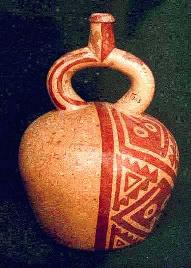
Two thousand years ago a mysterious and little known civilization ruled the northern coast of Peru. Its people were called
the Moche.
They built huge and bizarre pyramids that still dominate the surrounding countryside; some well over a hundred feet tall.
Many are so heavily eroded they look like natural hills; only close up can you see they are made up of millions of mud bricks.
Several of the pyramids, known as 'huacas', meaning sacred site in the local Indian dialect, contain rich collections
of murals depicting both secular and sacred scenes from the Moche world. Others house the elaborate tombs of Moche leaders.
The Moche greatly expanded the art of pottery, making realistic forms of animals and people engaged in activities of everyday
life and spiritual ceremony. Northern PeruBecause the pre-Columbian cultures left no written records, it is through their
pottery that we learn the most about them. In this group of artifacts look for the main Moche god, Aiapaec, who is depicted
by a human figure with a tiger's mouth and snarling fangs.
The Moche lived and developed the Lambayeque Valley from 100 to 700 AD...
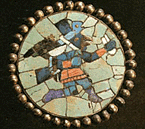
|
| winged chasqui |
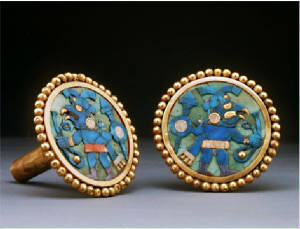

Chimu culture
|
 |
|
Inti Sun god
Because the Inca religion was based
around nature, the sun was perhaps the most important aspect of life because it provided warmth and light. Inti therefore
is also known as the Giver of Life. He was worshipped mostly by farmers who relied on the sun to receive good harvests. Although
he was the second most revered deity after Viracocha, he received the greatest number of offerings. The Sapa Inca, as ruler
of the people, claimed divine heritage and direct descent from the Sun.
INTI-Sun god. Inti's image is a golden disk with a human face surrounded by bright rays. Every day Inti soars across the sky
to the western horizon, plunges into the sea, and swims under the earth back to the east. Inti's sons are Wirakocha, Pachacomac,
and Manco Capac.
Chakana cross
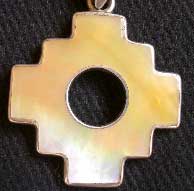
|
| chakana cross |
A Chakana (or Inca Cross, Chakana) is an Andean symbol. It is the three-stepped cross representing the southern cross and
symbolising the three tiers of Inca life. The lower world, this world and the higher world. The three levels also represent
the snake, puma and condor. Many buildings, temples, and religious sanctuaries are scattered with relevance to the chakana.
Sacsayhuamán Temple, located in Cusco, Peru, has a stone entrance shaped to form the upper portion of the chakana. Artifacts
and jewelry still made by Inca descendants often depict the chakana. The hole in its centre denotes Cusco, termed "the
navel of the Inca empire" and also represents the circle of life. Its Twelve external corners are believed to mark the
Twelve months of the year, While the four arms of the cross represent North, South, East and West. The three different levels,
representing the three worlds: Hanan Pacha, the world of above (representing the gods of the sun, moon and stars); Kay Pacha,
this world (representing this life); and Uqhu Pacha, the world of below (representing death). Each of these worlds was represented
by an animal: the condor, the puma and the
snake. It is important to note that these worlds do not correspond to the Christian ideas of Heaven, Earth and Hell. In
fact, the negative imagery associated with the snake, for example, was not shared by the Incas.
Nazca Culture
(sometimes spelled Nasca) is the name of a system of valleys on the southern coast of Peru, and the name of the region's largest
existing town. It is also the name applied to the Nazca culture that flourished in the area between 300 BC and AD 800. They
were responsible for the Nazca Lines and the ceremonial city of Cahuachi; they also constructed an impressive system of underground
aqueducts that still function today.
The Nazca culture flourished in the Nazca region between 300 BC and 800 AD. They created the famous Nazca lines and built
an impressive system of underground aqueducts that still function today.
|
 |
|
|
|
 |
|
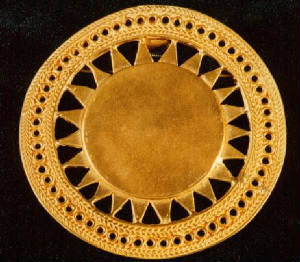
The festival of Inti Raymi, which honours the sun-god, now attracts thousands of tourists each year to Cuzco, the ancient
capital of the Inca empire.
The festival of Inti was held during the winter solstice, which was around June 24 in the Incan Empire. The festival was
held in Cuzco and was attended by the four nations of Tahuantinsuyu. In Quechua, Inti Raymi, means "resurrection of the
sun." Military captains, government officials, and the vassals who attended were dressed in their best costumes, and
carried their best weapons and instruments.
Preparation for the festival of Inti Raymi began with a fast of three days, where also during those days there was no
fire lit and the people had to refrain from having sex. This festival itself would last nine days, and during this time the
people consumed massive amounts of food and drink. There were many sacrifices as well which were all performed on the first
day. After the nine days everyone would leave with the permission of the Inca back to their states.
Tolima culture
In the hot mid-Magdalena valley and on the slopes of the central and eastern ranges in northern Huila and Tolima provinces,
remains dating back 16,000 years have been found that were left by groups of hunters, fishermen and gatherers. Later, fish,
lizards, crickets and fantastic beings in which features of various species were combined were cast in gold. Symmetrical pendants
evoke man in different degrees of schematization, while men, bats and feline figures merge in a continuous stream of transformations.
In one breastplate found in Calarcá, Quindío, the human body is restricted to two dimensions but is set in multiple symmetries,
the whole being brought to life by the shine and the skilful play of the decorative motifs. The backs of funeral chairs portray
the human figure in schematized form, surrounded by amphibians and reptiles.
Chimu Culture

|
| Tumi ceremonial knife |
The centre of the Chimú culture (850-1450 A.D.) was the city of Chan Chan in the Moche river valley. The ruins of the
city cover almost an area of 20 square km. With the help of conquests and warfare the Chimú people made up a state which,
during its glory days, ruled over a coastal strip of land of 1000 km that almost reached the northern border of Peru. The
Chimú state was at its largest during its late stage (1350-1450 A.D.) having defeated the Sicán culture in the north. The
Chimú state competed long also with the Inca state, which suppressed it round about the year 1450 A.D.
Tumi - Ceremonial knife
The Tumi is a sacrificial ceremonial knife distinctly characterised by a semi-circular blade, made of either bronze, copper,
gold-alloy, or silver alloy used by some Inca and pre-Inca cultures in the Peruvian Coastal Region.
Nazca lines
|
 |
|
|
|
|
|
|
<a href="http://www.lissapynn.com/" title="mellisa pynn art"><img src="http://www.easy-poll.com/counters/free_counter.185091.png"
alt="mellisa pynn art" border="0" /></a>
<br><a style="font-size: 8pt; font-family: Arial; font-weight: normal" href="http://www.easy-poll.com/counters/">counter</a>
|

|

maps - timeline

Inca Jewellery
|


2007-2025. Javas Roe - Ancient Sacred
Arts - Unique jewellery under the influence of ancient cultures / Inca / Pre-inca / Egypt /
|
|
|
 |

